F2G “super Corsair” Race #57 – Special Hobby 1/48
Background
While many believe that the Goodyear F2G Super Corsair began life as the answer to the threat posed by the Kamikazes beginning in November 1944, such is not the case.
Had Goodyear waited till then to begin developing such an airplane, it would never have been completed. In fact, the concept of such a super Corsair began in 1939, when Pratt & Whitney first proposed the R-4360 Wasp Major 28 cyliner four-row radial engine, which would provide an amazing 3,000 horsepower. Once Pratt & Whitney had created the monster, Vought began work in 1942 to discover how to mate it to the Corsair. The development work was turned over to Goodyear, which was manufacturing the Corsair under license as the FG-1. In early 1944, long before there was any thought of suicide bombers attacking Navy task forces, Goodyear took a standard FG-1A and mated it with the R-4360.
The big problem was cooling the engine; getting air back to that last row of cylinders took a major effort in ducting inside the cowling and was never really resolved until the introduction of a large doghouse downdraft intake that could pressurize the air and get it back there. The engine provided a 50% increase in power, and at low altitude the Corsair was capable of 431 m.p.h. at 16,000 feet, which was considerably faster than a standard Corsair at that altitude. Further tests on F4U‑1 BuNo 02460 and two FG‑1s, BuNo 13471 and BuNo 13472, showed the aircraft capable of close to 400 m.p.h. below 5,000 feet, with a climb rate of 7,000 feet per minute. Flown as an interceptor, the aircraft could reach 34,000 feet in less than 5 minutes, which was twice the rate of climb of the F4U-1A, and faster than the first of the new jets.
On the strength of these tests, the Navy ordered ten F2G-1 aircraft with non-folding wings and ten F2G-2s with folding wings and standard carrier equipment. Goodyear took the opportunity to cut down the rear fuselage and provide the pilot with one of the biggest and clearest bubble canopies of any wartime fighter.
When the threat of the Kamikazes appeared, the Navy finally broke down and brought the Corsair into the fleet, sending Marine F4U squadrons to the fast carriers to supplement the F6Fs that were the standard fleet defense fighter. Goodyear took the opportunity to press for full production of the F2G on the grounds it could provide high-speed low-altitude fleet defense against suicide bombers. The Navy, however, now had a better answer: Grumman had just come up with the F8F-1, which had stunned everyone at the Fighter Conference in October 1944, when it outflew everything there. Powered by the standard R-2800 which did not present the difficulties of the R-4360, the Bearcat was even faster at low altitude, not to mention being far more maneuverable than the F2G. Goodyear's hopes for their fighter were for naught.
By August 1945, five F2G-1 and five F2G-2 aircraft had been completed, in addition to the five development aircraft that had begun life as FG-1s. With the end of the war, the contract was canceled for the remaining airplanes. The F2Gs were transferred to the Naval Air Technical Center at NAS Patuxent, for further testing. With the advent of jets making any further development of piston-powered fighters redundant, the F2Gs were not flown much.
In 1946, the National Air Races came back. This time, rather than the purpose-built racers of the 1930s, the racers took advantage of the fact that surplus fighters like the P-51, the P-38, and the P-39 could be obtained for as little as $500. The 1946 race saw a clean sweep by ex-USAAF fighters.
Cook Cleland, one of the great “personalities” of Naval Aviation during World War II, had entered an FG-1 Corsair in the 1946 event, but it had been outperformed by the P-39s. In 1947, Cleland was asked by his old friend, Fleet Admiral William F. Halsey, what it would take for a Corsair to win. Cleland replied that the Corsair was really a high-altitude performer, and suggested that if there was a way for him to get hold of some of the F2Gs which were such fantastic performers at low altitude, that a Corsair might win. Cleland didn't have to do a lot of convincing of Halsey that this would be good for Navy public relations. Halsey arranged the paperwork, the F2Gs were declared surplus, and Cook Cleland got hold of five of them.
There wasn't much time to do anything to the F2Gs other than change the paint scheme. Cleland won the 1947 Thompson race in F2G #94, while his partner, Navy test pilot Deck Becker, took second place in F2G #74, which established them as the racers to beat. In 1948, both F2Gs were highly modified, with enlarged intakes to provide air to the last row of cylinders, and the wings reduced in span. However, both were forced to drop out during the race due to engine backfiring that dislodged #74's air intake scoop in the third lap and #94's scoop in the fourth lap.
In 1949, Cleland returned with three F2Gs, while Ron Pucket had a fourth, #18. Cleland's #94 was even more modified, as was Becker's #74. Ben McKillen would fly the new F2G, #57, which originally was supposed to be used as a source of spare parts rather than fly. Thus, it was not as radically modified as the other two, keeping the full‑span wing.
No. 74's gear reduction box stripped it gears just after Becker's qualifying lap, forcing him to make an emergency landing and removing him from the line-up. On race day, the F2Gs made a clean sweep: Cleland took first place, winning the Thompson Trophy a second time, with Ron Puckett close behind in #18, while McKillen came in third in #57. McKillen went on to take First Place in the Tinnerman Race.
Unfortunately, the fatal crash of Bill Odom in his P-51 was the nail in the coffin for pylon air racing. Unlike the pre-war races where companies could test new engines and designs, the surplus wartime fighters were a technological dead-end. The aircraft companies that had sponsored teams like Cleland's dropped out, which meant the 1949 Thompson Trophy Race was the end of the line until air racing picked up as “the world's fastest motor sport” in Reno in 1964, where it is really just an exercise in nostalgia and entertainment by those with money to burn.
Cleland flew F2G #57 in public for the last time when he put on a an aerobatics routine during show at his airport in Willoughby, Ohio in June 1950. Shortly after, he was recalled to active duty for the Korean War and the F2Gs were all placed in storage. In 1964 Cleland became interested in making an attempt on the world propeller driven, land plane speed record, using #57, when he heard of Darryl Greenamyer's plans. Cleland was able to obtain sponsorship from the Martin Decker Corp. Dick Becker and Chuck Toman disassembled #57 and shipped it to Pottstown, Pennsylvania to be rebuilt. Unfortunately, it was stored outdoors where it deteriorated until the Decker Corp. went bankrupt. Between 1964-1996, the remains were bought by three different individuals who were interested in restoring it, but each was killed in turn in flying accidents. In 1996, airplane was purchased by Bob Odegaard, who restored it to flying status in 1999. The airplane appeared at the Reno Air Races and air shows around the country, including the 2006 Planes of Fame show, where I saw him put the airplane through a superb aerobatics show. In 2007, Odegaard commenced the restoration of F2G #74, which he completed in the summer of 2012. On September 8, 2012, he crashed this Corsair while performing a low altitude run during preparations to race the airplane in that year's Reno Air Races, and was killed.
The kit
Outside of a vacuform conversion done by War Eagle to be used with the Otaki Corsair, and a resin conversion set done by Lone Star Models to convert the Tamiya Corsair, this kit by Special Hobby is the only 1/48 designed‑for‑the‑purpose kit of the F2G Corsair that has been produced. Aviation Usk did the airplane in 1/72, and there is a very good resin conversion set designed by Rodney Williams and produced by Obscureco to turn the 1/32 Revell Corsair into an F2G.
The kit includes two very clear and sharply‑molded vacuform canopies, which is good because this is a model where preserving the beautiful lines of the original means closing the canopy. With no visual distortion as might have been the case with an injection‑molded canopy, this will allow the cockpit to be seen with the canopy properly positioned.
Modelers have long expressed interest in getting a kit of this version of the Corsair. As it sits in the box, the kit makes up as Race 57 appears today, with an air intake that is different from what was used in 1949. This intake is the same kind used by Cleland on #94 and #74, so if one purchased the decals that Red Pegasus made for these airplanes, creating a model of either would mostly involve clipping the wings. There is the additional problem that while the model has the fabric-covered wings that were used in the Thompson Trophy racers, the cockpit is the one modified by Bob Odegaard during the restoration, which used all-metal wings from an F4U-5. Thus, out of the box, the kit is neither fish nor fowl. The standard F2G-1 and F2G-2 used the more modern F4U-4 cockpit, which is how they were in 1947-49. Fortunately, the True Details resin F4U-4 cockpit fits this kit very closely. Thus, the main problem for a modeler in creating Race #57 as she originally appeared is to get the “doghouse” air scoop. Mike West of Lone Star Models did one, though it is not in his catalogue at present.
I don't know why, but this kit didn't get built over the past nine years, despite my interest in the airplane. I recently rediscovered it when cleaning out and rearranging my kit storage closet. It had managed to get knocked over by a kitten and lodged behind the stack of unbuilt kits some time ago, where it became “out of sight, out of mind.” I decided to put it to the top of the “To Do” pile.
I began by assembling the wing. The resin parts for the different air intakes in the wing fit very nicely, while the walls for the wheel wells don't. I sanded them down and got them to fit.
I then painted the True Details cockpit. I had discovered that the F2G cockpits were just like F4U-4 cockpits then, black. I picked out details and painted the molded-on seatbelts, then inserted the assembled cockpit and glued the fuselage together. I then attached the wing and horizontal stabilizers to the fuselage.
I was surprised to find that the resin engine, which has to be assembled from 28 separate cylinders, actually fit inside the cowling, since that isn't always the case with Special Hobby kits. I painted the engine, attached it to the fuselage, and then slid the cowling over it. I sanded down all the seams after covering them with Mr. Surfacer.
I made the doghouse intake using the kit intake part and some Evergreen sheet, with a good heavy coat of Mr. Surfacer 500, which I then smoothed to make it look like the photos I had.
I gave the model an overall coat of Tamiya “Flat White,” following that with a good coat of Tamiya “Gloss White” to give the model as smooth a surface as possible.
The exact color of red on Race #57 is subject to debate. After seeing the airplane in person at Planes of Fame, I think most modelers have gotten it a little too dark. It is more of a scarlet red. I masked off the front of the cowling and the tip of the rudder, and painted the model with Xtracrylix “Red Arrows Red,” a nice British Scarlet, which looked right when I checked it against the color photos I had of the airplane from its visit. I thinned this considerably and misted it on with several passes. I then let it dry and saw where the “holidays” were and gave it a second, slightly-thicker coat. When all was dry, I unmasked the model and gave it a coat of Future.
I had harbored some doubt about whether these decals would be opaque enough to go over the red surface, but was pleasantly surprised to find they were nice an opaque, even though they were quite thin. They went on the model with no problem and settled under a light coat of Micro-Sol. When they were set, I washed the model to get rid of solvent residue, then applied a coat of Xtracrylix Satin varnish, which is a “scale” gloss coat - painting a 1/48 model with gloss varnish makes it look like a toy.
I had previously Futured and painted the vacuform canopy. I carefully fitted it in position, anchoring it with cyanoacrylate, then running white glue around the base to fill any gaps. This glue dries clear, so the final look of the canopy is right. I then attached the landing gear and gear doors, and the prop.
The F2G Corsair is one of those airplanes that just plain looks good. I think it looks better as a racer than as a military airplane, and the scheme for Race #57 is the best of all the racing Super Corsairs. I now only lack a prototype Corsair (a major modification project from any available kit) to have a model of each of the major sub-types and aircraft used by other services.
This is an easy kit to build. Given that the cockpit should be black for the 1949 version, one could get away with the kit cockpit if you don't want to spring for the resin cockpit. Making the doghouse is not as difficult as it might appear, and anyone who has done any kit modifications should have no problems.


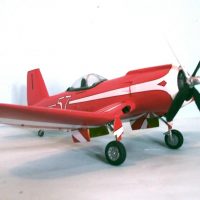
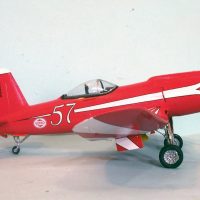

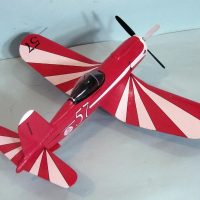
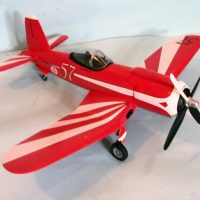
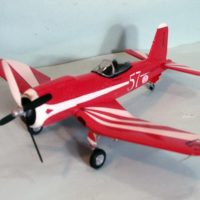
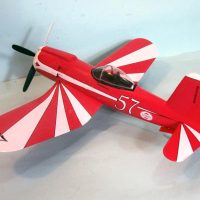

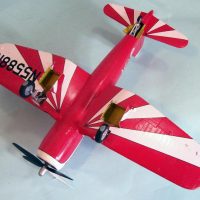
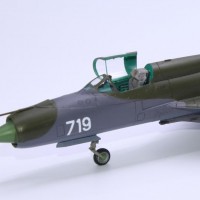
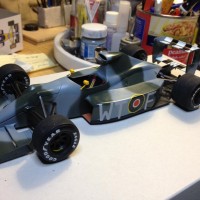
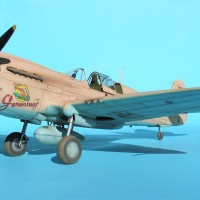
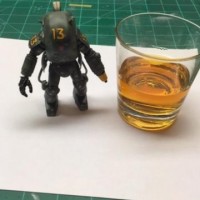
Beautiful model Tom…..I really like racers a lot, and yours is a outstanding. It's a shame that racers, with their interesting schemes, are not more popular with modelers.
terrific build
Wholly Molly Tom! That is a beautiful model. Thanks for adding the very interesting history. And just for S&Gs. You are the only man who I have heard use the term "holiday" in many years. My Dad use to say when I mowed the lawn. "And don't take any holidays". I thought he thought I was leaving for vacation. Enough of that.
A really great model of aviation history.
California Steve
You don't ever want a Navy Chief to tell you you have too many "holidays."
Looks nice Tom, have you got any pics of the engine please ?
Well done sir, a fine example of a racer.
Sorry - no engine pix - that shot I took at the field was the closest I could get and some museum volunteer proceeded to chase me away from that.
Awesome! I plan to use post office red (xtracolour) on my Race 57- its languishing in a box right now! You have inspired me to pull mine back out! I was not too impressed with how they rendered the area on the belly framed between the lower cowl flaps and the oil cooler intakes.
Crawling low enough to look at and get shots of the F2G belly at Seattle and some online pics I found of he restored Race 57 have made me reshape what is on the SH kit to a degree. I need to get some other things built though!
Thanks for the writeup- yours has been one of, if not THE clearest and concise description/explanations of how the F2G came to be- as well as some great racer background info.
I can assure you, you'll have fun. PO Red might be a bit dark, but as long as it's a scarlet red, you're in the ballpark.
Very nice Tom, and I wholeheartedly agree with your comments re: gloss finishes looking toy-like (unless they're car models, which somehow just look right).
It certainly makes for an attractive model. As for 'gloss' finishes, I definitely feel they should be scaled down.
Beautiful job, Tom. That's got to be one of the most difficult paint jobs to pull off correctly, but, you nailed it !
Nicely done Tom and thanks for the F2G history as well as the fine model. I have built the military version of that kit but found it to be a bit more difficult to build than your experiences with it. Everything needed to make a fine model is included in that kit and your build certainly reflects that.
Tom,
Beautifully done.